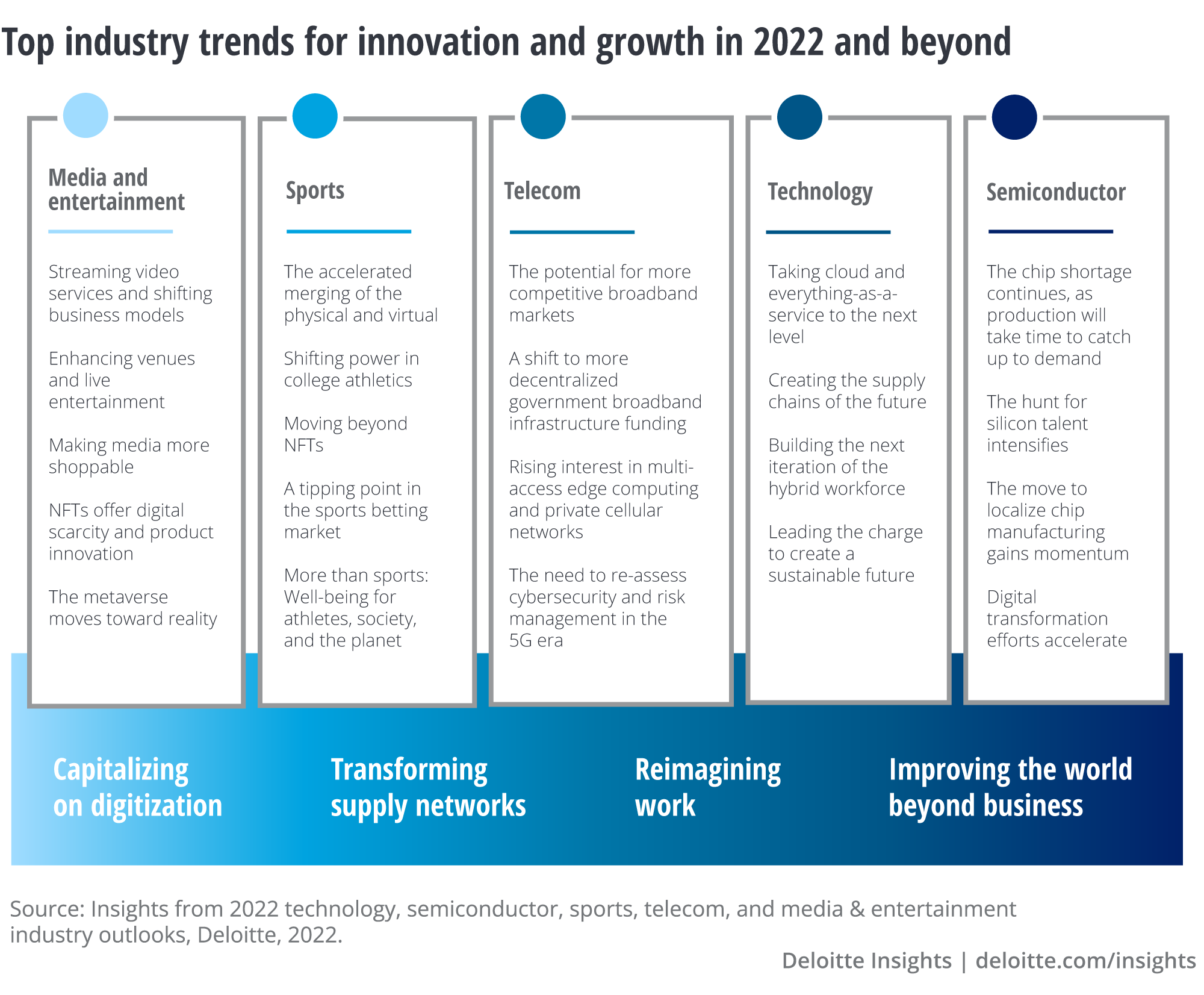Top TMT industry trends and emerging issues to tackle in 2022
Critical issues for TMT companies looking to build a new future

Armed with the experiences of living through the acute disruptions and systemic challenges caused by the pandemic, TMT leaders have an opportunity to be more deliberate and purposeful as they prepare for the future. Over the last two years, established trends have evolved, and new opportunities, new competition, new technologies, and new responsibilities have sprung up at the edges of markets. Innovations defined by interactivity, immersion, and social connection are being enabled by the technology, telecom, and semiconductor industries. These, in turn, are helping drive new opportunities for media and entertainment and sports organizations.
To explore these shifts in detail, Deloitte’s industry leaders recently published outlooks for 2022 for the technology, semiconductor, telecom, media and entertainment, and sports industries. These viewpoints highlight strategic issues for organizations in the coming year and their impact, as well as critical questions to ask and key actions to take.
- Technology: The technology industry has largely thrived over the past two years, but that momentum may not be sustainable without additional change. To help enable the next wave of growth, technology companies should address several challenges. These include managing the technical and operational complexities of multi-cloud approaches, rebuilding supply chains with better visibility and resiliency, preparing their hybrid workforce for the long term, and heightening their focus on reducing and reversing environmental impact.
- Semiconductor: The semiconductor industry cemented its place as truly essential during the pandemic. The chip shortages of 2020 and 2021 will likely persist through 2022—with significant financial impact. To remedy this, the industry is looking to invest hundreds of billions of dollars to meet overall growing demand for things like AI, data centers, high-performance computing, health care, and automotive applications. The industry is also looking to localize manufacturing more over the next few years. This will likely require taking new approaches to finding and developing the necessary talent.
- Telecom: In 2022, the industry will see increased competition in broadband markets, and around multi-access edge computing and private cellular networks. Consumers will have increased choice, with access to more high-quality options from telecom, cable, wireless, and satellite internet providers. The industry will also be looking at how to spend the US$65 billion from the federal government for continued broadband adoption and deployment in the United States.1 Finally, cybersecurity challenges will likely get more attention as 5G adoption becomes widespread and new risks are exposed.
- Media and entertainment: On the surface, changes for 2022 appear incremental, with a continued focus on competing for time-strapped audiences. But the reality is that there are deep undercurrents reshaping the landscape. Content is coming from everywhere. Social media is becoming increasingly shoppable. Non-fungible tokens (NFTs) are bringing scarcity and exclusivity to the internet. Popular games are social destinations and are creating their own economies. Enthusiasm for virtual worlds is growing. As worlds blur, media and entertainment companies will likely see new opportunities, changed business models, and the potential for unanticipated consequences.
- Sports: In 2022, the blending of the real and digital worlds will accelerate for sports, with growing opportunities for NFTs and immersive technologies (e.g., augmented reality). College athletics will see some of its biggest changes ever, with student-athletes exercising more self-determination. Blockchain-enabled innovations will evolve and potentially open entirely new markets. Sports betting companies will relentlessly pursue customers as the industry matures and consolidates. Finally, the influence of sports in society will continue to receive attention, focusing on sustainability and mental health, among other areas.
Beneath the surface, there are some fundamental threads that connect these industry trends, emerging issues, challenges, and opportunities.
- Capitalizing on digitization: Fifty plus years into the Information Age, you think we would have already digitized everything that we could. Obviously, that isn’t the case. Companies are continuing to digitize processes to improve efficiency and they are working to create new categories of innovation by replicating our physical world in the digital realm. From intelligent supply chains to NFTs to hyperquantified athletes to digital twins and virtual worlds—all of this is made possible through increasingly pervasive, high-speed connectivity. As the line between the real and virtual continues to get more ambiguous, companies should look at more responsible ways to benefit.
- Transforming supply networks: Several industries are struggling with supply challenges that may persist into 2023. To respond, companies should take what they have learned from the pandemic to prepare for potentially more disruptive shocks. This should include improving their agility and flexibility through better real-time insight, powered by better information sharing with partners. Manufacturing may also need to change with a reevaluation of nearshoring and localization strategies and a more comprehensive view of talent, energy and water usage, and tax policy.
- Reimagining work: People’s work-related attitudes and expectations have likely permanently changed. This, in combination with fierce competition for creative and technical talent, are challenging companies’ long-term strategies. They are evolving their organizations to better take advantage of hybrid work environments, through cultural, technological, and policy changes. They should broaden where they look for critical skills, moving beyond traditional geographic areas and education levels. They also should reevaluate the role of automation in all aspects of their operations, making sure it not only drives efficiency, but also amplifies workers’ capabilities and makes work more fulfilling.
- Improving the world beyond business: Companies across industries are increasingly recognizing and acting on their broader responsibility to society, driven by the desires of employees, investors, and customers. This is manifesting in a more strategic and thoughtful approach to things like sustainability, physical and mental health, and responsible data usage. A greater emphasis on these areas is necessary to help ensure continued access to investment and high-quality talent and to help focus companies as they prepare for a more complex regulatory environment around ESG reporting and compliance.